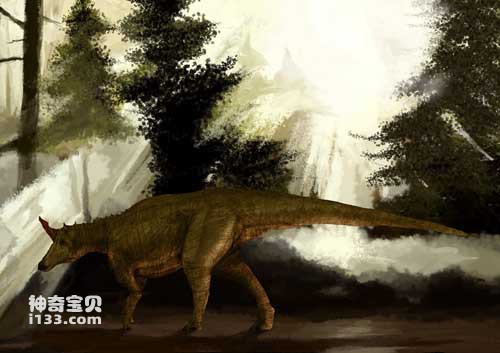Members of the hadrosaur family are known for their gentleness, elegance, and beauty. If we say the "beautiful man" among the hadrosaur family, Qingdaosaurus, which was discovered in Shandong, my country, deserves the title. Qingdaoosaurus is the most famous crested hadrosaur fossil discovered in my country, and it is also the first complete dinosaur fossil discovered in my country. Because it was discovered in Xigou, Jingangkou Village, Laiyang City, near Qingdao, and has a shaped crest on its head, it got its name.
The age of the strata where the Qingdaoosaurus fossils are located is the Late Cretaceous. It is 6.62 meters long and 4.9 meters tall. It has a wide and flat lower jaw, shaped like a duck's beak, with a large number of teeth. The end of the ischium is enlarged in the shape of a foot, the upper part of the intestinal bone is raised high, and there is an obvious straight-edge structure in the middle of the ventral side of the sacral vertebrae. , into a groove shape at the back of the structure, the crest in the frame is actually an edged stick-like spine growing on the nasal bone quite far back, much like a unicorn horn, extending straight from between the eyes. Reach forward. It is estimated to have weighed about 6 to 7 tons when alive, but its brain was very small, weighing only 200 to 300 grams.
The physical features of Qingdaosaurus don't seem to be much different from the "standard" duck-billed dinosaur, except that it has an extra slender horn on its head, which looks like a unicorn. Some say the horn should be tilted forward, others say it should be tilted backward, and still others say the horn does not exist at all. As for the role of this horn, there are even more divergent opinions. It is neither a weapon nor can it amplify its cry like other crested duck-billed dinosaurs. Then, it is a kind of decoration. However, it has been suggested that this canal spine may be a displaced (or misplaced during restoration) nasal bone that was mistakenly placed in a vertical position in front of the skull. If this is the case, then Qingdaoosaurus may be a flat-headed hadrosaur.

Chinese name: Qingdao Dragon
Latin name: Tsintaosaurus
Age of survival: Late Cretaceous
Fossil origin: Shandong, China
Physical characteristics: 6~7 meters long
Diet: plants
Species: Ornithopods
Definition: Lizard from Qingdao
animal tags: Tsintaosaurus
We created this article in conjunction with AI technology, then made sure it was fact-checked and edited by a Animals Top editor.